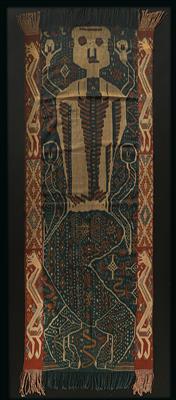Indonesia, Sumba island: A large, long ceremonial textile ‘Hinggi’, with a figure on a blue background.
Indonesia, Sumba island: A large, long ceremonial textile ‘Hinggi’, with a figure on a blue background.

The island of Sumba has a particularly important position in the exceptionally rich and old textile culture of Indonesia. The present ceremonial cloth, ‘Hinggi’, comes from east Sumba. The wide middle stripe out of cotton has a light, sand-coloured background and is dyed in complicated Ikat technique. The blue tones are obtained from ‘indigo’, the red-brown tones come from the sap of the ‘Morinda’ tree. For the Ikat dyeing technique, before the weaving some warp threads are tightly bound off so as not to pick up any new colour by subsequent dyeing. This procedure is repeated according to the number of the projected colours – and then weaving commences. As a result, during Ikat dyeing, one must already know before the dyeing and weaving what should later appear on the textile. The motifs of this ‘Hinggi’: in the central axis stands a large human figure (probably an important ancestor); next to the head of this dominant figure can be seen a small half-figure with raised arms; in the middle of the ‘Hinggi’, two snakes with human heads flank the central figure; in addition, there are smaller motifs in various reddish-brown and brown Ikat dye tones: snakes, birds, eight-pointed stars and other geometric forms. The two border stripes along the long sides, to the left and right of the Ikat-dyed central piece, show four light dragons on a red ground and, separating them, each side has one piece with dense geometric decoration. These framing borders were woven in weft technique. Earlier on the island of Sumba these ceremonial textiles ‘Hinggi’ were assigned supernatural powers. Worn around the shoulders, they should protect the wearer from the influence of ‘evil powers and spirits’. They were exchanged as bride price and on the occasion of other transactions between families, and they served as protective shrouds at burials of noble deceased. The ceremonial textile presented here shows no damage. Dimensions: c. 225 cm x 71 cm. First half to mid-20th century. (ME)
Provenance: Austrian Private Collection.
Lit.: ‘Traditional Indonesian Textiles’ by John Gillow, fig. 170.
Esperto: Prof. Erwin Melchardt
 Prof. Erwin Melchardt
Prof. Erwin Melchardt
+43-1-515 60-465
erwin.melchardt@dorotheum.at
02.11.2015 - 14:00
- Prezzo realizzato: **
-
EUR 625,-
- Prezzo di partenza:
-
EUR 500,-
Indonesia, Sumba island: A large, long ceremonial textile ‘Hinggi’, with a figure on a blue background.
The island of Sumba has a particularly important position in the exceptionally rich and old textile culture of Indonesia. The present ceremonial cloth, ‘Hinggi’, comes from east Sumba. The wide middle stripe out of cotton has a light, sand-coloured background and is dyed in complicated Ikat technique. The blue tones are obtained from ‘indigo’, the red-brown tones come from the sap of the ‘Morinda’ tree. For the Ikat dyeing technique, before the weaving some warp threads are tightly bound off so as not to pick up any new colour by subsequent dyeing. This procedure is repeated according to the number of the projected colours – and then weaving commences. As a result, during Ikat dyeing, one must already know before the dyeing and weaving what should later appear on the textile. The motifs of this ‘Hinggi’: in the central axis stands a large human figure (probably an important ancestor); next to the head of this dominant figure can be seen a small half-figure with raised arms; in the middle of the ‘Hinggi’, two snakes with human heads flank the central figure; in addition, there are smaller motifs in various reddish-brown and brown Ikat dye tones: snakes, birds, eight-pointed stars and other geometric forms. The two border stripes along the long sides, to the left and right of the Ikat-dyed central piece, show four light dragons on a red ground and, separating them, each side has one piece with dense geometric decoration. These framing borders were woven in weft technique. Earlier on the island of Sumba these ceremonial textiles ‘Hinggi’ were assigned supernatural powers. Worn around the shoulders, they should protect the wearer from the influence of ‘evil powers and spirits’. They were exchanged as bride price and on the occasion of other transactions between families, and they served as protective shrouds at burials of noble deceased. The ceremonial textile presented here shows no damage. Dimensions: c. 225 cm x 71 cm. First half to mid-20th century. (ME)
Provenance: Austrian Private Collection.
Lit.: ‘Traditional Indonesian Textiles’ by John Gillow, fig. 170.
Esperto: Prof. Erwin Melchardt
 Prof. Erwin Melchardt
Prof. Erwin Melchardt
+43-1-515 60-465
erwin.melchardt@dorotheum.at
|
Hotline dell'acquirente
lun-ven: 10.00 - 17.00
kundendienst@dorotheum.at +43 1 515 60 200 |
| Asta: | Tribal Art |
| Tipo d'asta: | Asta in sala |
| Data: | 02.11.2015 - 14:00 |
| Luogo dell'asta: | Wien | Palais Dorotheum |
| Esposizione: | 28.10. - 02.11.2015 |
** Prezzo d’acquisto comprensivo dei diritti d’asta acquirente e IVA
Non è più possibile effettuare un ordine di acquisto su Internet. L'asta è in preparazione o è già stata eseguita.
